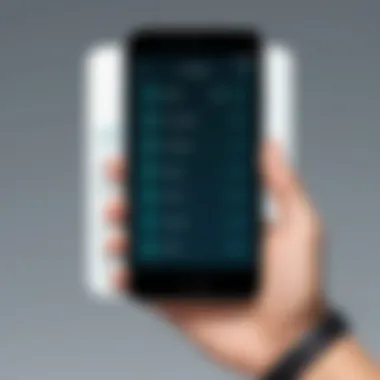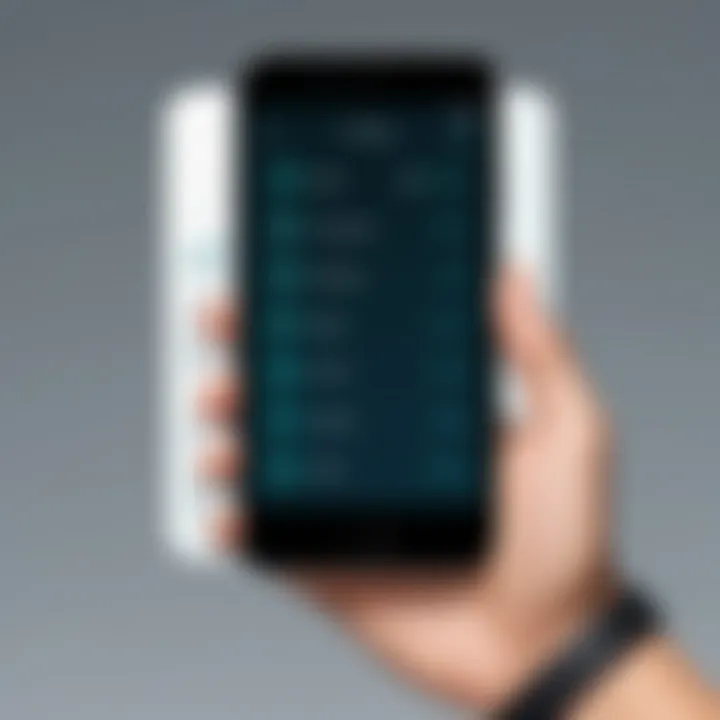Complete Guide to Cell Phone Number Validation Techniques


Intro
In an age where communication flows as freely as the air we breathe, the validation of cell phone numbers has become crucial. Imagine launching a marketing campaign, only to discover a mound of incorrect phone numbers has tarnished your outreach efforts. Such a scenario reflects the importance of ensuring that the digits we rely on are not only valid but ready for action.
This guide aims to dissect the intricate layers of cell phone number validation, from the fundamental techniques used to ascertain number authenticity to the significant ramifications of errors in this realm. Developers, business owners, and analysts will find invaluable insights that can fundamentally enhance customer engagement.
With technology underpinning almost every communication, understanding these aspects can not only streamline interactions but also bolster confidence. Today, we'll explore software and methodologies that make validation operable in real-world applications, while also examining the tools available for those committed to refining their data integrity.
Understanding Cell Phone Number Validation
In an increasingly digital world, effective communication relies heavily on accurate contact information. Cell phone number validation is one of the key processes ensuring that businesses and service providers maintain reliable channels for reaching their clientele. Oftentimes, organizations face the challenge of managing vast pools of data, which can lead to inaccuracies. These inaccuracies can manifest in various ways, such as misspellings or incorrect formats. Thus, understanding the essentials behind cell phone number validation is not just a technical necessity but a strategic advantage for organizations aiming for customer satisfaction and operational efficiency.
Definition and Importance
Cell phone number validation refers to the practices used to confirm that a phone number meets the required format and is genuinely active. The significance of this practice extends beyond just keeping a tidy database.
- Customer Trust: When users see that businesses are prompt and accurate in their communications, it fosters a level of trust. Miscommunications can lead to frustration and can tarnish a brand’s reputation.
- Operational Efficiency: Validating numbers upfront saves time and resources. When organizations filter out incorrect numbers in their databases, they reduce the chance of failed messages or misdirected calls.
- Regulatory Compliance: As privacy laws tighten, ensuring data integrity becomes paramount. Maintaining accurate customer information helps organizations stay clear of potential compliance issues.
Ultimately, a well-defined validation process can enhance personalizations, bolster communication strategies, and even support marketing efforts—ensuring outreach aligns with actual users.
Common Validation Techniques
When it comes to validating cell phone numbers, various techniques are employed based on the specific needs of an organization.
- Format Checking: This is the most elementary form of validation. It uses patterns to ensure the number adheres to a particular structure. Typically, a phone number is assessed followed country and local standards, considering whether or not it has the correct number of digits.
- Carrier Validation: In this technique, the number is verified against known carriers to ensure that it exists and can receive calls or messages. This has become increasingly crucial amid the rising prevalence of VoIP and disposable numbers.
- Verification Services: Many third-party services can validate whether a number is active. These service providers offer APIs that can be integrated into applications for real-time validation.
- User Feedback: A participatory approach can be beneficial. Allowing customers to confirm or correct their numbers at an initial point of contact ensures accurate information.
- Regular Audits: Periodically checking the database can help catch inconsistencies over time. Regularly validating entries ensures information remains up to date and reduces data decay.
"Maintaining valid contact numbers is like keeping a well-oiled machine—all parts must function correctly for optimal performance.”
In summary, understanding and applying these techniques is crucial for any business that aims to provide excellent customer service while ensuring data integrity.
The Mechanisms of Phone Number Formats
Understanding the various mechanisms of phone number formats is essential for anyone involved in the realm of validating cell phone numbers. This knowledge not only aids in ensuring accuracy but also supports effective communication in a global landscape. Every country has its own unique system of assigning and formatting numbers, which results in a tapestry of standards and patterns.
Grasping these elements can significantly enhance the reliability of communication systems, decrease the risk of errors, and boost confidence in data handling. Whether you're developing applications that require number validation or analyzing customer data, acknowledging the underpinnings of phone number formats can be invaluable.
International Formats and Standards
International formats lay the groundwork for understanding how phone numbers are structured across the globe. The International Telecommunication Union (ITU) has outlined standards that help define these formats. A notable example is the E.164 standard, which specifies that a phone number may contain a maximum of fifteen digits, including the country code, national destination code, and subscriber number.
To illustrate, a theoretical number from the United Kingdom might appear as +44 20 7946 0958. Here, the +44 is the country code, which signals the dialing format to users in any part of the world. Recognizing these distinctions is critical for developers to implement validation tools that can discern between local and international formats.
Some important points to note:
- Country-Specific Codes: Each country has its unique dialing codes. Familiarity with these allows for better user experiences.
- Standard Lengths: Different countries have varying lengths for their numbers. For example, U.S. numbers generally comprise ten digits, while some areas in Europe may have longer formats.
- Trunk Prefixes: These are often used in domestic dialing but omitted in international formats. Knowledge of this helps in seamless conversions.
By leveraging these guidelines, not only does the potential for miscommunication diminish, but it can also streamline processes such as data collection and customer engagement.
Local Formats and Patterns
When turning our gaze to local formats and patterns, the beauty of specific rules becomes apparent. Local numbering formats can appear quite varied even within a single country, influenced by regional telecommunications policies, urbanization, and technological advancements.
For instance, in the United States, a typical number format might be represented as (555) 123-4567. Here, the first three-digit segment represents the area code, while the subsequent segments denote the local exchange and line number. Similarly, in Germany, the numbers follow a different pattern, such as 030 12345678 when dialed within Berlin, relying on a specific area code.
Key aspects to consider include:
- Regional Variations: Many countries feature area codes that signify geographical locations, which can differ widely even among neighboring regions.
- Mobile vs. Fixed Lines: The formatting can change, too. Mobile phone formats in certain locales may include the mobile code and have different numbers than those for landlines.
- Formatting Varies by Carrier: Different telecommunications providers may have their own approaches to formatting, impacting how numbers should be validated.
Understanding these local formats helps further refine the validation process, ensuring that the intended audience can be reached efficiently.
"Inaccurate formats can lead to missed connections and opportunities, emphasizing the necessity of meticulous validation practices."
With these mechanisms in place, validating cell phone numbers can transform into a straightforward process, paving the way for clearer communication and enhanced customer relationships.
The Role of APIs in Validation Processes
The integration of Application Programming Interfaces, or APIs, into cell phone number validation processes is like the backbone of a house—supporting the entire structure of data verification and accuracy. APIs serve as the underlying technology that enables software applications to communicate, share, and utilize data with ease. In the context of validating cell phone numbers, they provide businesses and developers with essential tools to ensure that the contact information they collect is legitimate and operational.
Modern ecosystems rely heavily on information exchange. One critical aspect of this is ensuring that the phone numbers entered into systems are not only formatted correctly but also currently active. This validation is pivotal for a multitude of functions: from sending out verification texts to facilitating two-factor authentication. Having robust APIs in place reduces the occurrence of errors, thereby enhancing customer communication and trust.
"A well-implemented API can drastically cut down the time spent on data hygiene, allowing teams to focus on more strategic tasks."
Overview of Popular APIs


When it comes to validating cell phone numbers, several APIs have carved a niche for themselves in the tech landscape. Here are a few prominent names worth noting:
- Twilio: This is a heavyweight in the communication domain. Twilio provides services that allow businesses to send messages and make calls. Its phone number validation API can determine if a number is valid and what carrier is being used.
- Numverify: A straightforward API aimed specifically at number validation and lookup. It enables businesses to gather detailed information about the phone numbers they are working with, such as the location and carrier.
- Austin's Data: This lesser-known player specializes in providing detailed insights into phone number validity along with historical data, which can be important for businesses looking to vet leads thoroughly.
- Nexmo: Now part of Vonage, Nexmo offers APIs for messaging and voice services, along with number validation features that can help with fraud prevention and enhancing user experiences.
Choosing the right API can depend on various factors from pricing to specific features offered. Each comes with its own advantages which can dramatically affect user interaction.
Integration Strategies for Developers
Integrating APIs into applications for the purpose of validating phone numbers is a relatively straightforward process, but it requires some best practices to ensure efficiency and robustness. Here are a few strategies to consider:
- Assess Requirements: Before selecting an API, developers need to assess the unique requirements of their application. Determine what information is most crucial. Is it just validation, or do you need carrier info too?
- Utilize SDKs: Many reputable APIs come with Software Development Kits (SDKs) which simplify the integration process. These kits often include pre-written code snippets that help developers focus more on functionality rather than boilerplate code.
- Rate Limiting Awareness: Most APIs enforce rate limits. Understanding these limitations helps in planning the frequency of validation checks without resulting in failures due to excessive calls.
- Error Handling Framework: Having a clear error handling framework in place is crucial. It’s important to anticipate and manage scenarios where the API service might be down or returning invalid data, as this can severely impact user experience.
- Testing and Validation: Before going live, proper testing needs to be conducted to ensure that the integration works smoothly. This should include test cases for both valid and invalid phone numbers to confirm that the API responds as expected.
Through these strategies, developers can create a solid foundation for integrating APIs into their systems, ensuring that they get the most out of their validation efforts, enhancing both operational efficiency and user experience.
Regular Expressions for Validation
In the world of data entry, the importance of validating cell phone numbers cannot be overstated. One of the most powerful tools at a developer's disposal for such validation is regular expressions. These sequences of characters allow for sophisticated search and manipulation of text. In the realm of cell phone validation, regex can help ensure that only correctly formatted and valid numbers make their way into databases. By implementing regex, businesses can reduce errors, improve user experience, and maintain data integrity—all crucial for effective customer interaction.
Understanding Regex Basics
To get started with regular expressions, one must grasp some fundamental concepts. Regex consists of a combination of literals and metacharacters. The literals are straightforward, representing the actual characters you want to match, while the metacharacters are symbols that influence how patterns are interpreted. A basic understanding might be as simple as knowing that a dot () matches any character, while a caret () indicates the start of a string.
The core usage of regex centers around matching patterns. For instance, if you wanted to check a string for the presence of numbers, you would utilize characters like to signify word boundaries or to indicate digits. These building blocks enable precise and effective evaluation of user inputs, allowing developers to catch false entries right off the bat.
Creating Regex Patterns for Numbers
When crafting regex patterns specifically for phone number validation, certain considerations come into play. It’s not merely about having a sequence of digits. Different countries have varying formats, such as area codes, country codes, and even spacing or punctuation. Here are a few fundamental patterns to create:
- Basic 10-digit pattern: A typical U.S. phone number might be expressed as . This matches numbers like 123-456-7890 or 1234567890.
- Including country codes: For international formats, one might extend this to . Here, the signifies the presence of a country code, and the optional groups cover local variations such as parentheses or dashes.
Here's an example regex pattern encapsulating those aspects:
This pattern allows for comprehensive validation of North American and some international phone numbers, accounting for format variations, while still enforcing the rules necessary for valid entries.
By adopting regex within validation frameworks, not only do developers ensure data cleanliness, but they also enable systems to handle user input more intuitively. Such attention to detail might seem inconsequential, but in the high-stakes world of communication, accuracy is paramount.
Challenges in Number Validation
Validating cell phone numbers can, at first glance, seem like a straightforward task. However, the reality is far more intricate than many anticipate. Ensuring that phone numbers are not only correctly formatted but also active and valid presents its own set of challenges. Every small hurdle has the potential to affect not just the technical aspects of communication but also the overall user experience, trust, and satisfaction. This intricate web of challenges calls for a closer examination, especially for software developers and IT professionals navigating this field.
Handling Different Carrier Formats
Phones are not just phones—they are gateways into various communication ecosystems. Different carriers adopt distinct formats for their numbers, and these formats can change not only from region to region but also from one month to the next. As a result, a coder working on a validation algorithm must embrace a dexterous approach when addressing the nuances of these carrier-specific formats.
Consider this scenario: A developer in the U.S. validates numbers that often start with three-digit area codes, a mainstay in the country. But how does one approach validating a number from a less familiar area, such as Liberia, where the formats can be drastically different? From distinguishing local from international prefixes to handling the peculiarities of number-length variations, the task can become a tangled mess.
To combat these variations effectively, a dynamic and flexible validation system can be built utilizing well-structured regular expressions. Here’s a practical concept:
The code above serves as a foundational regex pattern that accommodates various international formats.
Dealing with Invalid Numbers
Perhaps the most disheartening aspect of phone number validation is the prevalence of invalid numbers. Whether due to typographical errors or entirely made-up sequences, these invalid entries can seep into databases with alarming ease. Each false number that slips through can cost businesses not just in terms of resources, but in lost customer trust as well.
Handling invalid numbers involves implementing preventive and corrective measures. For instance, initially validating the syntax before proceeding to a deeper level of analysis can be beneficial. Using a tiered approached for evaluation ensures that superficial errors get weeded out early in the validation process. Consider the following:
- Syntax Check: Ensure it follows the prescribed pattern using regex.
- Range Check: Verify whether the number falls within a valid range for the respective country or region.
- Telecom Check: Utilize APIs that provide services to check whether the number has an active status.
"An ounce of prevention is worth a pound of cure." It’s a statement that rings true even in the digital age.
Simultaneously renouncing poorly formatted contact info is crucial as well. For businesses relying on customer communication, a simple form field for phone numbers, complete with validations, can significantly cut down on invalid entries.
In summary, while the challenges of number validation may seem cumbersome, approaching them with innovative strategies can yield effective solutions. Real-world implications stretch from operational efficiency to enhanced user trust; thus, it's imperative for those in software development to tackle these issues head-on and stay vigilant in the constant quest for accuracy.
Data Privacy and Compliance Issues
In the realm of validating cell phone numbers, data privacy and compliance have become critical topics. As digital communication continues to evolve, so do the laws and regulations governing how personal data should be managed. Understanding these issues is essential not only for meeting legal standards but also for building trust with customers.
When businesses collect cell phone numbers for validation, they are also handling sensitive personal information. This responsibility blurs the lines between usability and privacy. Non-compliance can lead to severe penalties and can tarnish a company's reputation. Hence, it’s wise to familiarize oneself with the regulations that govern data handling.
Regulations Affecting Data Handling


Various regulations worldwide shape the landscape of data privacy. Here are some of the most relevant laws:
- General Data Protection Regulation (GDPR): Enforced in Europe, it sets strict guidelines for collecting and processing personal information. Companies must obtain explicit consent from individuals for their data to be processed. Violations can result in hefty fines.
- California Consumer Privacy Act (CCPA): Affecting businesses that serve Californian residents, the CCPA provides rights to consumers regarding their personal data. Companies must disclose what data is collected and allow individuals to opt-out of its sale.
- Telephone Consumer Protection Act (TCPA): This U.S. law regulates robotic calls, your texting practices, and the use of autodialing systems. Understanding TCPA is crucial when validating numbers, as it governs how and when you can contact individuals.
These regulations are not merely red tape; they serve to protect individuals’ privacy and ensure that companies handle data responsibly.
Best Practices for Compliance
To navigate the legal landscape effectively, companies should adopt several best practices to ensure compliance:
- Obtain Explicit Consent: Always inform users why their phone number is needed and how it will be used. Implement clear consent forms that users can easily comprehend.
- Data Minimization: Collect only the information that is necessary for validation purposes. Avoid asking for more data than you need, as this increases the risk of non-compliance and data breaches.
- Regular Data Audits: Periodically review and assess your data handling processes. An audit can help identify any weaknesses or compliance issues before they become problematic.
- Implement Security Measures: Use encryption and other technologies to protect users' data. Ensuring the integrity and confidentiality of personal information is paramount.
- Training for Employees: In-house training programs can help employees understand the importance of privacy laws and the organization's protocols for handling sensitive data.
"Data isn’t just a boundary line; it’s a bridge to trust. Handling it correctly paves the way for lasting relationships with customers."
By paying attention to these practices, businesses not only comply with existing laws but also build a foundation of trust with their customers. This forms the bedrock of a successful operation in today's digitally-driven marketplace.
Impact of Incorrect Validation
Validating cell phone numbers is not merely a matter of administrative diligence; it holds profound implications that stretch across various sectors. The impact of improper or thwarted validation can ripple through an organization, affecting everything from reputation to revenue. For businesses operating in a digital realm, where communication is key, the weight of these consequences becomes acutely evident.
When companies fail to validate numbers correctly, they often face two major issues: ineffective communication efforts and data integrity problems. As pithy as it may sound, inaccurate numbers are like fishing without bait; businesses throw out marketing messages and outreach efforts, hoping for a catch only to reel in disappointment.
Consequences for Businesses
The ramifications of incorrect validation can run deep for businesses, particularly those heavily reliant on customer engagement through SMS or calls. Consider the following:
- Lost Revenue: Companies lose potential sales when marketing campaigns hit dead ends. Campaigns targeting unverified numbers are wasted opportunities.
- Brand Reputation: Continually reaching out to invalid numbers can paint a negative picture. Customers may be less willing to engage with brands perceived as unprofessional.
- Resource Misallocation: Time and money spent trying to reach numbers lacking validity can take a toll on an organization’s bottom line.
- Lower Conversion Rates: If leads are directed to non-existent numbers, conversion rates drop, affecting overall performance metrics such as ROI.
In light of these considerations, it's crucial for businesses to prioritize number validation as a pivotal component of their operations, rather than a mere afterthought.
Effects on User Experience
A seamless user experience hinges significantly on effective communication. When validation practices fall short, the negative impact can be felt on the customer’s side all too well. Users who attempt to engage with a business may encounter:
- Frustration and Confusion: Invalid numbers can lead to misleading information. If customers are directed to numbers that aren't in service, their frustration mounts.
- Decreased Trust: Trust is a currency, especially in a digital arena. Continual failures in contact practices can shatter trust, driving customers away permanently.
- Unmet Expectations: When users expect prompt replies but face radio silence due to number issues, it leads them to re-evaluate their loyalty.
"A business that cannot effectively communicate with its customers is like a ship adrift; there is no direction, and it is vulnerable to the storms of competition."
Best Practices for Validating Cell Phone Numbers
Validating cell phone numbers is a critical element to maintain communication integrity in any business operation. An effective validation process not only reduces the chances of erroneous data entry but also aids in building trust with customers. Let’s break down some of the key best practices to ensure robust validation.
Implementing Validation at Entry Points
Setting up validation procedures right at the entry stage is paramount. When users input their cell phone numbers, the process should include a few key functionalities:
- Real-time Format Check: This refers to providing instant feedback to users regarding the format of the phone number they are entering. When a number is being typed, it is helpful to highlight invalid entries immediately, which saves users from going through a cumbersome error process later on.
- Input Masks: Employing an input mask can significantly enhance user experience. For instance, forcing a specific format (like (###) ###-####) guides the user and minimizes the chances of entering incorrect data.
- Confirming User Input: Incorporating a confirmation step where users re-enter their phone numbers is a great way to verify accuracy. This additional layer can catch mistakes that may slip through during the initial input.
Remember, an ounce of prevention is worth a pound of cure.
Through these strategies, businesses can effectively capture accurate user information right from the start, which cuts down on time and resources needed to rectify errors later.
Regular Audits of Data Integrity
Even with strict entry point validations, the war against invalid phone numbers doesn't end there. Regular audits of existing data are necessary to ensure continued accuracy and reliability. Here are a few practical components for conducting those audits:
- Data Cleansing: Set a fixed schedule to run routines that identify and remove duplicates or clearly invalid numbers. Automated systems can notify when numbers appear suspiciously formatted or do not match expected patterns.
- Feedback Loops: Encourage feedback from users about the updates to their contact information or any issues they experience during communication. This proactive approach can help in identifying and correcting discrepancies early on.
- Usage Analytics: Monitor the engagement levels of phone numbers through messages or calls. If certain numbers consistently bounce back or do not engage, it's a signal for further investigation.
By committing to a structured audit process, organizations not only preserve the value of their data but also enhance their relationships with customers, reinforcing a sense of trust and reliability.
Emerging Trends in Number Validation Technology
The world of technology is always moving quicker than a jackrabbit on a date. One of the fields seeing revolutionary changes in recent years is phone number validation. The relevance of emerging trends in this sector cannot be overstated. As businesses and applications continue to rely on verified communication paths, understanding the latest techniques becomes necessary. Not just to weed out incorrect data but to provide robust security and user confidence.
Artificial Intelligence and Machine Learning
Artificial Intelligence (AI) and Machine Learning (ML) are the rock stars of today’s tech landscape. They are shaping how we approach validation, making processes more efficient and scalable. Rather than relying on static rules, AI can analyze vast amounts of data, learning from each validation step.
Consider this picture—an e-commerce platform that sees millions of transactions every day. Relying on traditional validation methods can lead to errors, wasting time and money. Machine learning models can adapt over time, improving accuracy in real-time. This adaptability is crucial, especially as number formats change or when new carriers emerge in the market.
Some benefits of using AI and ML include:
- Improved Accuracy: Algorithms can learn from historical data and spot patterns that humans might miss.
- Automation: Validation processes can run in the background without constant oversight, freeing up resources.
- Predictive Capabilities: Systems can not only validate a number but also predict its validity based on carrier trends or user behavior.
Implementing AI doesn’t come without risks, though. Data used to train these models must be handled carefully to ensure privacy and compliance. It’s a double-edged sword, but when managed wisely, the payoffs can significantly enhance number validation.


Blockchain for Secure Verification
Blockchain technology is carving a significant niche in various industries, not least for validating phone numbers securely. The decentralized nature of blockchain means that once a piece of information is verified, it is set in stone and cannot be tampered with.
Imagine a healthcare application needing to verify patients' phone numbers for appointment reminders. Utilizing blockchain could ensure the information is encrypted and immutable, providing an extra layer of security against fraud or data breaches.
Key considerations include:
- Transparency: Each transaction on the blockchain is visible to all participants, which reduces the risk of falsifying data.
- Decentralization: Removes the single point of failure, making verification more resilient to attacks.
- Traceability: Every step in the validation process can be traced back, providing a clear history of verifications.
However, blockchain isn’t a magic bullet. Implementing it involves complexities and costs related to infrastructure and energy consumption, which can be a concern for smaller businesses. Proper evaluation is necessary to determine if the benefits outweigh the drawbacks.
"In the ongoing battle against fraud and data inaccuracies, emerging technologies like AI/ML and blockchain are the knights in shining armor that businesses never knew they needed."
Case Studies of Successful Implementations
In understanding the landscape of cell phone number validation, looking at real-world scenarios can provide invaluable insights. Case studies are more than just statistics; they show how businesses tackle challenges, improve their processes, and ultimately enhance their user experience. For e-commerce platforms or healthcare applications, validating phone numbers becomes a pivotal point in their operations. The ability to communicate reliably can affect customer engagement and operational efficiency.
E-commerce Platforms
E-commerce platforms are a hotbed for customer interactions. They rely on validated phone numbers to ensure smooth transactions and reliable communication. Imagine a shopper who just bought a fancy new gadget. They expect a text message confirming their purchase and delivery details. Failing to deliver on this promise can lead to confusion and dissatisfaction.
For instance, a prominent online retailer implemented a sophisticated phone number validation system during checkout. The results were impressive. They reported a 20% decrease in order-related inquiries and a significant reduction in cart abandonment. The validation ensured that the right number was attached to each order, reducing miscommunications. Furthermore, real-time validation during the registration process allowed customers to receive essential updates instantly. Using tools like Twilio and Nexmo helped streamline the entire process, integrating easily with existing systems.
Noteworthy elements to consider:
- User Experience: Enhanced trust and satisfaction with accurate communication.
- Operational Efficiency: Reduced workload for customer service teams due to fewer inquiries.
- Data Integrity: Improved database hygiene, ensuring better marketing outcomes and targeting.
Healthcare Applications
In healthcare, cellphone number validation takes on a more critical role. Accurate patient information is crucial. Unverified phone numbers can delay notifications about test results or appointment reminders, which could affect patient care. Imagine a scenario where a hospital sends out recovery tips post-surgery but the patient never receives them due to a wrong number.
One rural healthcare provider tackled this issue head-on by integrating a validation system powered by Google Maps API. By cross-referencing area codes with the database, they ensured that numbers matched geographic regions. As a result, they achieved over 90% successful contact rates regarding appointment reminders.
Key takeaways from this case include:
- Patient Safety: Ensuring patients receive critical information promptly.
- Operational Flow: Streamlined communication enhances staff planning and resource allocation.
- Regulatory Compliance: Keeps patient data aligned with health regulations, generating fewer compliance issues.
Investing in a robust validation system not only safeguards patient data but also optimizes operational efficiency, ultimately leading to a healthier bottom line for healthcare providers.
Through these case studies, it is clear that implementing effective phone number validation systems can lead to substantial benefits in various sectors. Businesses not only gain from operational efficiencies but also enhance the trust and satisfaction of their clients.
Evaluating Validation Tools and Software
In today's fast-paced digital landscape, validating cell phone numbers is no longer just a good practice; it's essential for maintaining effective communication and ensuring business integrity. Evaluating the right validation tools and software can make a significant impact on operational efficiency and data accuracy. This section delves into the critical elements of evaluating such tools, highlighting the benefits and considering various factors that one should keep in mind.
Comparison of Features and Pricing
When selecting a validation tool, the comparison of features and pricing is paramount. Different tools come equipped with their own set of functionalities, and it is essential to align these features with your business needs. Here are some common features one might consider:
- Real-time Validation: This allows for immediate feedback to users when they input their phone numbers, reducing errors on the spot.
- Global Coverage: Some tools offer validation for numbers from various countries, which is particularly useful for businesses with an international footprint.
- Batch Processing: For organizations needing to validate a large number of numbers at once, batch processing features can save considerable time.
- Integration Capabilities: Tools that can seamlessly integrate with existing systems (like CRM or marketing platforms) are preferable, promoting a smoother workflow.
- Reporting and Analytics: Useful for tracking trends and insights from the validation processes, aiding in better decision-making.
Pricing is another significant factor and can widely vary. Some tools operate on a subscription basis, while others might charge per validation request. It's advisable to seek tools that offer a free trial or a tiered pricing model so that you can evaluate their performance before committing.
User Feedback and Ratings
User feedback is a goldmine when it comes to finding the best validation tools. Reviews and ratings on various platforms can provide insights into real-world performance and user satisfaction. Here’s how to approach user feedback:
- Check Trusted Sites: Look for ratings on reputable websites like Reddit, G2, or Capterra. These platforms often host detailed user reviews.
- Consider Consistency: A tool may have many glowing reviews, but also pay attention to any consistent complaints or issues noted by multiple users.
- Seek Case Studies: Some vendors showcase success stories on their site, providing a glimpse into how their product has helped other businesses.
"A tool’s value is not just in its features, but how well it meets the practical needs of its users."
End and Final Thoughts
This article has delved into various aspects of phone number validation, elucidating the mechanisms behind different formats, the role of APIs, and emerging technologies like artificial intelligence and blockchain. We also highlighted the challenges faced when dealing with carrier formats and the implications of invalid numbers. Having a robust validation strategy can drastically reduce errors and enhance operational efficiency.
Moreover, the practices and tools discussed provide essential frameworks for software developers and IT professionals. It's paramount for businesses to continuously invest in updating their validation processes, adapting to the evolving technological landscape and user behaviors.
"The importance of validation cannot be overstated; accurate data is the foundation upon which successful customer relationships are built."
Summary of Key Takeaways
- Importance of Validation: Accurate phone number validation is essential to maintain effective communication and operational integrity.
- Technological Mechanisms: Understanding the different formats, validation techniques, and API functionalities helps to select the right approach for specific needs.
- Challenges: Awareness of obstacles, such as the diverse standards adopted by carriers, aids in developing strategies to tackle them effectively.
- Future Trends: Staying informed about trends in AI and blockchain is critical for integrating advanced solutions into validation processes.
- Best Practices: Regular audits and validation at entry points significantly enhance data quality.
Future Directions for Cell Phone Number Validation
Going forward, there are several noteworthy directions for cell phone number validation that professionals in the field should keep an eye on. As the web and mobile applications evolve, so too will the methods and technologies associated with validation.
- Integration of AI and Automation: The application of machine learning can enhance predictive capabilities, identifying patterns in data to improve validation accuracy and automate processes. As AI systems become more entrenched, they’ll likely allow for real-time corrections during data entry, minimizing human error.
- Blockchain for Data Integrity: The decentralized nature of blockchain could be harnessed to create secure, immutable records of verified phone numbers. Such systems would increase trust and transparency in communication processes, essential in sectors like finance and healthcare.
- Regulatory Compliance: As privacy regulations tighten globally, ensuring that validation processes align with laws such as GDPR will be paramount. Adapting validation systems to comply with these laws while maintaining data accuracy will present ongoing challenges.
- User-Centric Approaches: Building validation systems that prioritize user experience by ensuring minimal friction during number entry can lead to improved data quality and user satisfaction.
As the technological landscape transforms, the importance of validating cell phone numbers will only amplify, driving businesses and developers to innovate and adapt in ways that enhance communication and foster trust.







